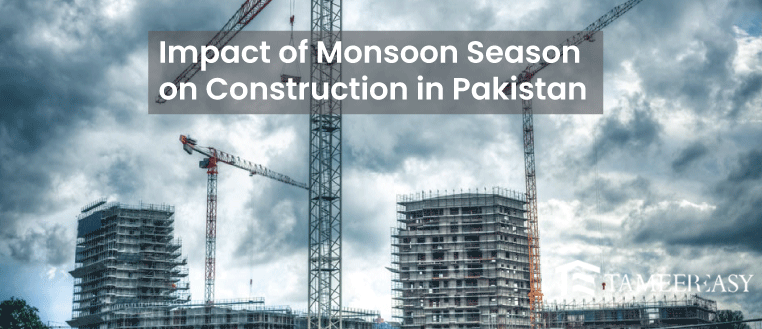The monsoon season greatly influences Pakistan’s climate since it relieves the country’s oppressive summer heat and replenishes its water supplies. However, they also present the construction industry with significant difficulties. Strong winds, flooding, and torrential rain can delay and interrupt construction projects and jeopardise their structural integrity.
An in-depth analysis of the effects of monsoon rains on Pakistani buildings is provided in this article, along with an examination of crucial countermeasures.
I. Impact of Monsoon Rains on Construction
Heavy rains during the monsoon can cause waterlogging, which impedes construction efforts and compromises the stability of foundations. Additionally, excessive precipitation can lead to soil erosion, which puts slopes and excavations at risk.
1). Structural Damage
Unchecked water seepage can weaken foundations, harm concrete buildings, and cause fissures in walls and floors. Moisture infiltration can hasten steel reinforcements’ corrosion, further jeopardising the stability of the structure.
2). Delays and Increased Costs
Due to poor working conditions, construction projects frequently experience lengthy delays and increased costs during the rainy season. These delays may lead to higher expenses, legal issues, and disruptions in project schedules.
3). Safety Hazards
Safety dangers for construction workers include slick surfaces, muddy conditions, and reduced vision by rain. Accidents and injuries occur more frequently during the monsoon, requiring increased safety precautions.
4). Material Damage
Severe rain can erode the quality and utility of building materials, including wood, plaster and cement. Excessive moisture absorption can cause materials to degrade, expand, and deform.
5). Poor Workability
It may be challenging to do construction-related jobs successfully during monsoon conditions. Concrete pouring, bricklaying, and other intricate finishing tasks become difficult, resulting in subpar work.
6). Reduced Productivity
Unfavourable weather conditions and the requirement for extra safety measures can impact how productive construction sites are. Reduced efficiency is caused by extended drying periods, short working hours, and logistical difficulties.
7). Equipment Malfunction
Electrical risks on building sites can result from malfunctioning electrical equipment from heavy rain and humidity. Ensuring the equipment is properly insulated and maintained is essential to prevent mishaps.
II. Monsoon Construction Precautionary Measures
1). Proper Drainage System
Drainage systems must be adequate and well-designed to effectively divert rainfall from construction sites. Effective surface and subsurface drainage reduces the possibility of structural damage and prevents waterlogging.
2). Waterproofing and Sealing
Applying the proper waterproofing compounds and sealants to basements, walls and roofs can stop water seepage and shield the building envelope from moisture damage.
3). Strengthening Foundations
Using the right soil compaction techniques and waterproofing measures in foundation construction helps reduce the danger of moisture damage.
4). Temporary Shelter and Protection
Construction sites and supplies can be protected from rain by erecting temporary shelters like tarps or tents. Avoiding harm from water by safeguarding exposed locations and delicate equipment.
5). Safety Measures
Enhancing safety procedures is essential during the monsoon. Safety risks can be reduced by giving workers the correct personal protective equipment (PPE), maintaining enough illumination, and putting anti-skid measures on surfaces.
6). Planning and Scheduling
Careful planning and scheduling of construction works can reduce exposure to rain and assist in avoiding crucial phases during periods of severe rainfall. Maintaining progress can be achieved by prioritising indoor jobs and modifying timelines accordingly.
7). Regular Inspections and Maintenance
Conducting frequent inspections before, during, and after rainy events enables the early identification of potential problems. Regular upkeep and repairs of any damage stop further degradation and cost growth.
8). Collaboration and Communication
During the monsoon season, communication is essential among all parties involved, including project managers, architects, and contractors. Planning for contingencies and close collaboration ensure prompt responses to weather-related problems.
Summary
The construction sector in Pakistan faces both possibilities and challenges during the monsoon season. The construction sector may successfully reduce the obstacles brought on by the seasonal rains by comprehending the effects of monsoons on construction projects and implementing appropriate measures, such as excellent drainage systems, waterproofing techniques, safety regulations, and thorough planning.
Implementing these methods guarantees projects’ structural integrity and timely completion, protecting the workforce’s well-being. Monsoon readiness must be understood by those working in the construction industry, and these techniques must be included in their work procedures.








